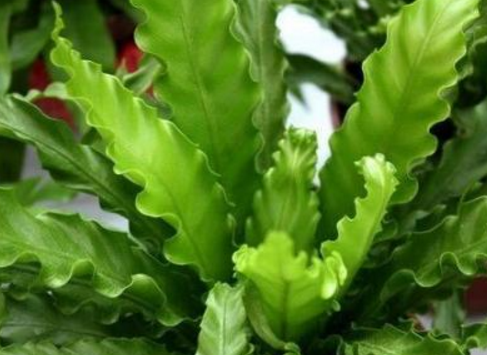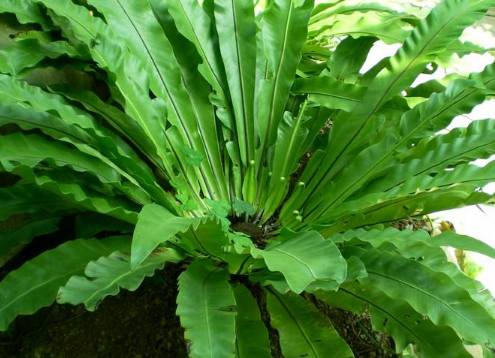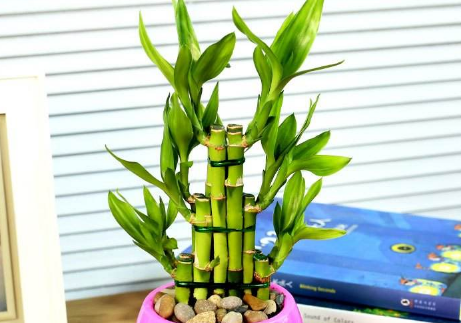What about the withered and yellow leaves of the bird's nest fern?
1. Temperature
Ensure that the normal growth temperature of the plant is about 22-27 ℃, and the lowest is not less than 5 ℃, otherwise the leaves will be frostbitten, scorched and the plant will wither.

two。 Humidity
In order to prevent the leaves from yellowing and drying up, we should often spray water on the leaves, keep them clean, and sprinkle water around to keep the environment moist.
3. Sunshine
Bird's nest fern should not be exposed to the sun for a long time, generally let the plant be exposed to astigmatism, indoor, but to be well ventilated. Of course, planting plants in the shade is more conducive to plant growth, receiving some light can make the leaves green and bright.
The above is the detailed watering method of the bird's nest fern, hoping to help you better maintain the bird's nest fern plant.
What if the leaves of the bird's nest fern turn yellow?
Bird's nest fern, also known as nest fern, mountain perennial fern, crown fern, is a perennial shady herbaceous foliage plant of the family Pteridaceae. Many flower friends have yellowing leaves when they breed bird's nest ferns. This article introduces what to do when the leaves of bird's nest ferns turn yellow.
What if the leaves of the bird's nest fern turn yellow?
Bird's nest ferns are often attached to tree trunks or rocks in rainforests or seasonal rain forests and are not resistant to strong light and belong to shade plants. Many flower friends' conservation environment, especially in the north, the air is dry, and the light is strong, so the bird's nest fern will appear the leaf edge is dry, the leaf is dry and cracked.
If you know the reason, you can know how to avoid it. First of all, you should try your best to ensure that the environment is shady and wet, and you can keep it in a shady place, not in bright places such as balconies and windowsills, especially in summer to absolutely avoid direct sunlight and often spray water. to ensure humidity, like yin does not mean unlimited watering, to ensure that the matrix is wet!
Growth habits of bird's nest fern
Bird's nest ferns are often attached to tree trunks or rocks in rainforests or seasonal rainforests. The nest of the cluster can hold a large number of dead branches and leaves, bird droppings and Rain Water, which are converted into humus and can be used as their own nutrients, as well as other tropical epiphytic plants, such as orchids and other tropical epiphytic ferns. Its ecological habit is that it likes high temperature and humidity and is not resistant to strong light.
The above introduces the causes and solutions of the yellowing of bird's nest fern leaves, and introduces the growth habits of bird's nest fern, hoping to help flower friends solve their current predicament.
What if the leaves of the bird's nest fern turn yellow? can the bird's nest fern absorb formaldehyde?
Bird's nest ferns, also known as nest ferns, mountain perennial ferns and crown ferns, are perennial herbaceous foliage plants of the family Pteridaceae. Many people like to raise bird's nest ferns in offices or living rooms, so what do we do if we know that the leaves of bird's nest ferns turn yellow? Can bird's nest fern absorb formaldehyde? Let's take a look at the answer in the next step.
What if the leaves of the bird's nest fern turn yellow?
Causes of yellowing of bird's nest fern leaves
Bird's nest ferns are often attached to tree trunks or rocks in rainforests or seasonal rain forests. They are not tolerant to strong light and belong to shade plants. If the light is too strong, the leaves of bird's nest ferns will turn yellow. It may also cause the yellowing of bird's nest fern leaves due to improper growth environment and improper maintenance. Especially in the north, where the air is dry and the light is strong, bird's nest ferns will dry up at the edge of the leaves and dry and crack the leaves.
The solution to the yellowing of bird's nest fern leaves
If you know the reason, you can know how to prevent the leaves of the bird's nest fern from yellowing. First of all, we should try to ensure that the environment is shady and humid, and can be maintained in a shady place, not in bright places such as balconies and windowsills, especially in summer to absolutely avoid direct sunlight and often spray water to ensure humidity. Like Yin does not mean unlimited watering, to ensure that the breeding bird's nest fern substrate is wet! We should also understand the growth habits of bird's nest ferns, understand the habits of bird's nest ferns, and adjust the habit of growing flowers according to the habits to avoid the yellowing of bird's nest fern leaves.
Can bird's nest fern absorb formaldehyde?
Bird's nest ferns can absorb formaldehyde, and ferns such as bird's nest ferns can purify the air indoors. In general, Cymbidium is a plant commonly used by citizens to absorb formaldehyde, and the effect of ferns absorbing formaldehyde is obviously better than it.
Five kinds of indoor ornamental ferns were selected to study the absorption capacity of formaldehyde. The results showed that all the five kinds of ornamental ferns had strong ability to absorb formaldehyde. Under the specific experimental environment, the ability of absorbing formaldehyde was as follows: Jinglan grass > kidney fern > bird nest fern > Dryopteris tricolor, which is of great practical significance to explore efficient and safe formaldehyde control of ornamental fern.
- Prev

The culture method of bird's nest fern
1. The suitable temperature for the growth of bird's nest fern is 22-27 ℃, which is not resistant to high temperature or cold, and can not be lower than 5 ℃ in winter. Too low temperature can easily cause the leaf margin to turn brown, and even cause plant death by frostbite. two。 The bird's nest fern is a negative herb and has little demand for light.
- Next

How to deal with the yellowing of Guanyin bamboo leaves
1. The reason for improper lighting: although Guanyin bamboo is a semi-shade plant, if the plant is over-illuminated, the leaf edge and branches will shrink, the leaf tip and leaf edge will wither, and the sunrise part will appear macula. If there is not enough light for a long time, the plant will not be able to carry out photosynthesis, and the leaves will turn yellow and then fall.
Related
- Fuxing push coffee new agricultural production and marketing class: lack of small-scale processing plants
- Jujube rice field leisure farm deep ploughing Yilan for five years to create a space for organic food and play
- Nongyu Farm-A trial of organic papaya for brave women with advanced technology
- Four points for attention in the prevention and control of diseases and insect pests of edible fungi
- How to add nutrient solution to Edible Fungi
- Is there any good way to control edible fungus mites?
- Open Inoculation Technology of Edible Fungi
- Is there any clever way to use fertilizer for edible fungus in winter?
- What agents are used to kill the pathogens of edible fungi in the mushroom shed?
- Rapid drying of Edible Fungi

